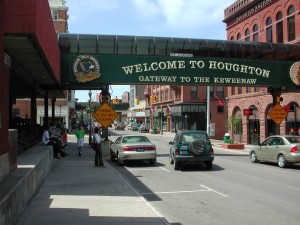Student “Experts” in Community Character

Originally appears in the Fall 2007 issue
As a social studies teacher and a citizen of a small rural community that is experiencing the kind of development usually associated with urban areas, I began to wonder what community characteristics were being sacrificed. Our community consists of two small towns built on opposing hillsides on a peninsula during the copper mining era of the 1800s and 1900s. When the mines closed in the 1960s, the population dropped dramatically and has never returned to the numbers of the earlier mining days. Yet in recent years, land has been cleared for a shopping mall. Mini-malls, along with big-box stores, are springing up and now dot the landscape. New residential areas are being built as the once grand old neighborhoods fall out of favor. New roads to these new housing developments are carving up the landscape. Our population has not grown, but our need for more room, to sprawl, apparently has grown, as has our need to shop! Meanwhile, public beaches and forested areas that townspeople have used and loved and taken for granted are disappearing from public use, being sold for private second-home waterfront development and industry.
With proposals for a new paper mill and, more recently, a sulfide mine, residents have become divided over how the community should grow, some favoring jobs and others seeking sustainable development rather than another boom-bust industry. The idea that our mining history might repeat itself — this time with a bigger appetite for resources and with technology that would damage the environment even more than before — left me with concerns. Missing from the debate, it seemed, was the concept of land ethics as articulated by Aldo Leopold, Sigurd Olson, Barry Lopez and many others. I began to wonder, “How does a community come to honor and protect its land and other resources? How can a community ‘grow’ a land ethic?” The answer, I believe, is that people must make a connection to the land and to their community in order for them to care about want happens to it.
I wanted my students to understand the history of their community and really look at their school, their homes, and their green spaces and visual environments, or “viewsheds.” I wanted them to consider what they like about where they live, what they want to preserve and what they are willing to give up. With this in mind, I worked with colleagues to develop a community-character unit stressing community planning, natural resource protection and the visual landscape. The teachers — in math, science, social studies, language arts and art — each worked on pieces of the unit that would fit into their curriculum and correlate with state and national content standards. Described below is the resulting 15-lesson unit, entitled Looks Count! Lasting six weeks, the unit provided students with opportunities to learn about the cultural and natural character of the community through in-class workshops and through surveying, assessing and developing an enhancement plan for one geographical area of the community.
This content is restricted to subscribers only.
If you are not yet a subscriber, please consider taking out a subscription here.
If you are an existing subscriber, kindly log in or contact us at info@greenteacher.com for more information.





